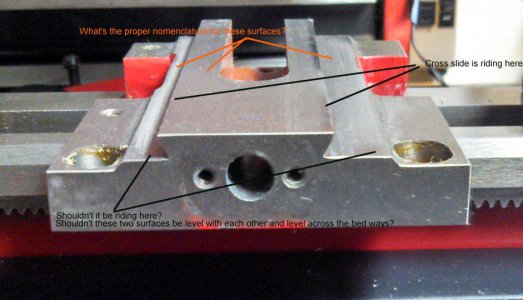I've decided to dive into improving the operation of my 7x10 lathe and am learning a lot in the process. I worked on the cross slide some and was able to smooth out the operation of it, but turned up some things that I'm fairly sure aren't right about it. I hope you'll forgive my lack of knowledge because I am certainly a newb. I don't know all the nomenclature for the parts of the cross slide dovetail so I pointed out a few thing on the photo below.
My next project after the cross slide was going to be an attempt at tapered saddle gibs, but on the advice given on some of the pages about it, I started checking the accuracy of the saddle and ways before doing anything with the gibs. What I've found is that it appears that no two surfaces of the saddle are aligned. The cross slide dovetail on the saddle drops about .006'" from front to back measured from the ways and one side is about .003" lower than the other. The cross slide gib rubs on the lower dovetail flat on the saddle, but the cross slide itself doesn't even touch it.
Am I correct in thinking that the cross slide should be riding the smooth bottom surfaces of it's "feet" rather than the rough underside that's riding on the top of the dovetail on the saddle?
Should I try to level the saddle front to back by taking down the inside of the saddle front V groove or shimming the back flat?
The only other machine I have is a HF Mill/Drill. Should I even bother trying to correct the saddle dovetail surfaces with that or would I be better off just getting another saddle from LMS? I don't mind risking the one I've got for the sake of a useful learning experience since a replacement is available.
Is it even safe to assume that another one would be any better?
What is the proper nomenclature for the various dovetail surfaces? What about the surfaces on the bottom of the saddle that it rides on?
I get mixed messages on brass vs. steel vs. cast iron cross slide and compound gibs. Is one better than another?
Sorry for the pile of questions, but like I said, I'm a rookie and I want to make things better the right way rather than making everything worse.
Here's what I'm talking about:

Thanks to all for the helpful info I've read on this forum. It's nice to know that a newb like me can ask questions about the basics here and get helpful replies.

My next project after the cross slide was going to be an attempt at tapered saddle gibs, but on the advice given on some of the pages about it, I started checking the accuracy of the saddle and ways before doing anything with the gibs. What I've found is that it appears that no two surfaces of the saddle are aligned. The cross slide dovetail on the saddle drops about .006'" from front to back measured from the ways and one side is about .003" lower than the other. The cross slide gib rubs on the lower dovetail flat on the saddle, but the cross slide itself doesn't even touch it.
Am I correct in thinking that the cross slide should be riding the smooth bottom surfaces of it's "feet" rather than the rough underside that's riding on the top of the dovetail on the saddle?
Should I try to level the saddle front to back by taking down the inside of the saddle front V groove or shimming the back flat?
The only other machine I have is a HF Mill/Drill. Should I even bother trying to correct the saddle dovetail surfaces with that or would I be better off just getting another saddle from LMS? I don't mind risking the one I've got for the sake of a useful learning experience since a replacement is available.
Is it even safe to assume that another one would be any better?
What is the proper nomenclature for the various dovetail surfaces? What about the surfaces on the bottom of the saddle that it rides on?
I get mixed messages on brass vs. steel vs. cast iron cross slide and compound gibs. Is one better than another?
Sorry for the pile of questions, but like I said, I'm a rookie and I want to make things better the right way rather than making everything worse.
Here's what I'm talking about:

Thanks to all for the helpful info I've read on this forum. It's nice to know that a newb like me can ask questions about the basics here and get helpful replies.


